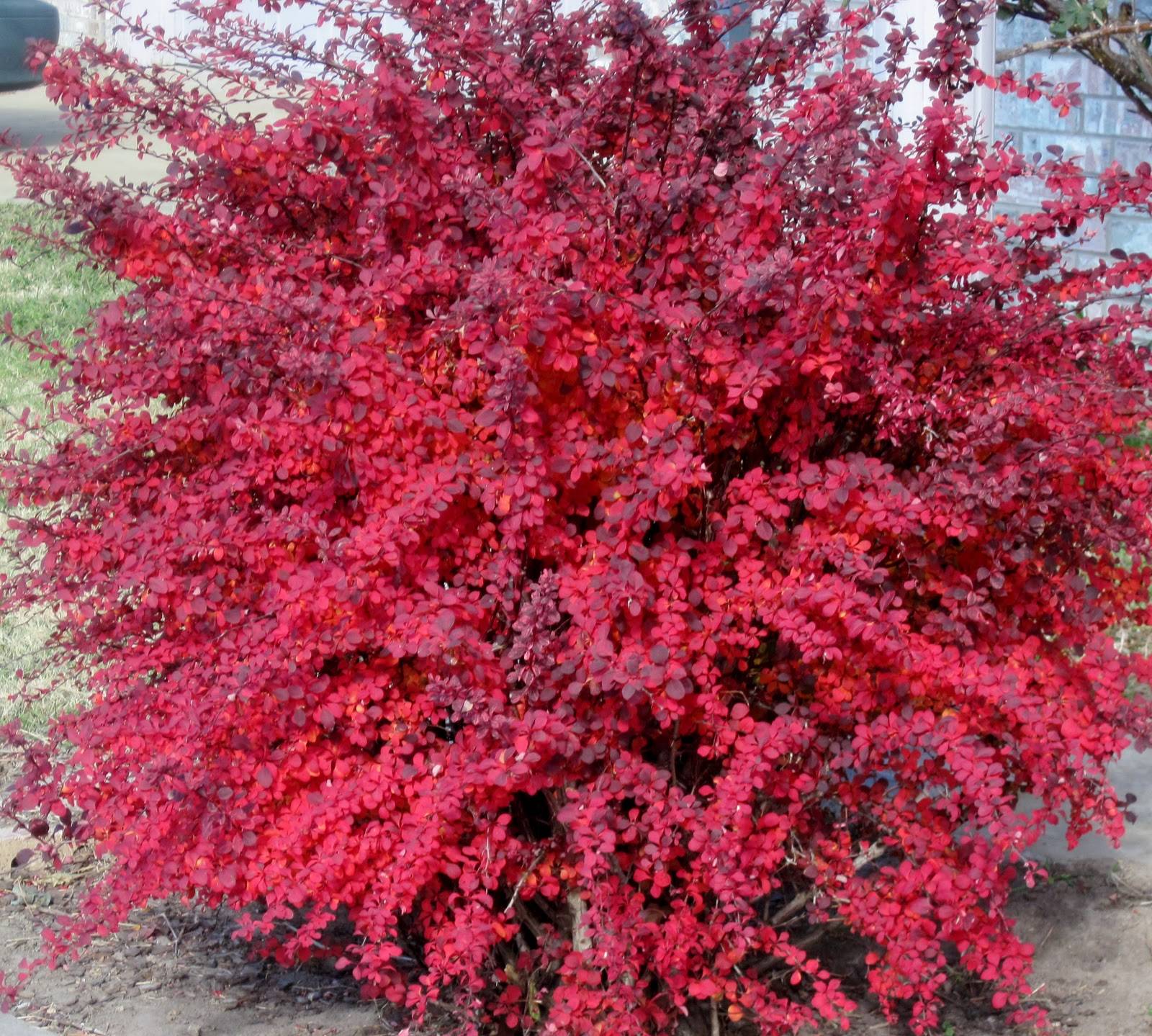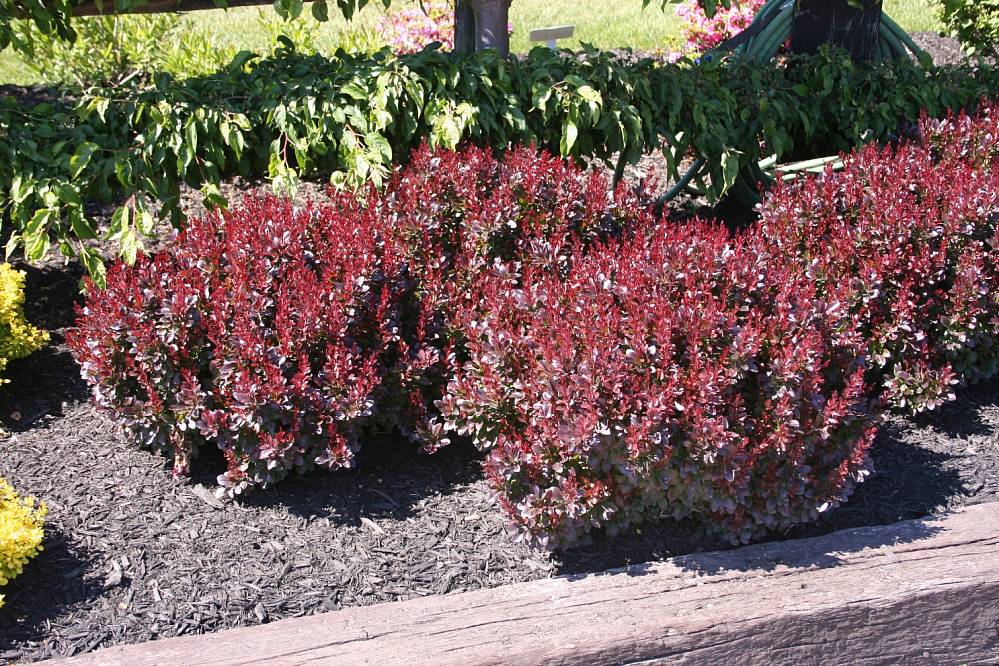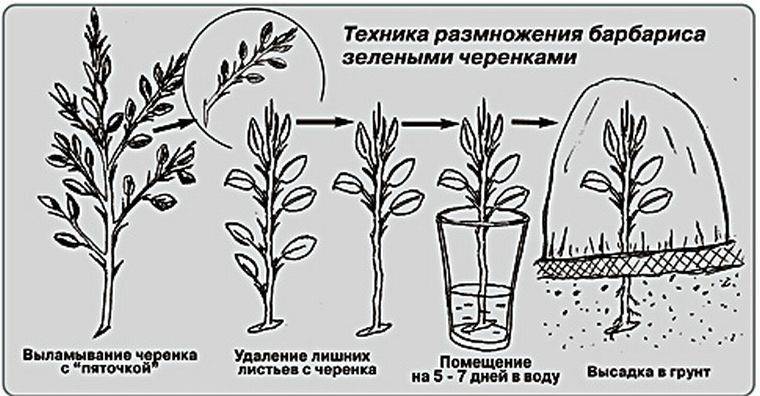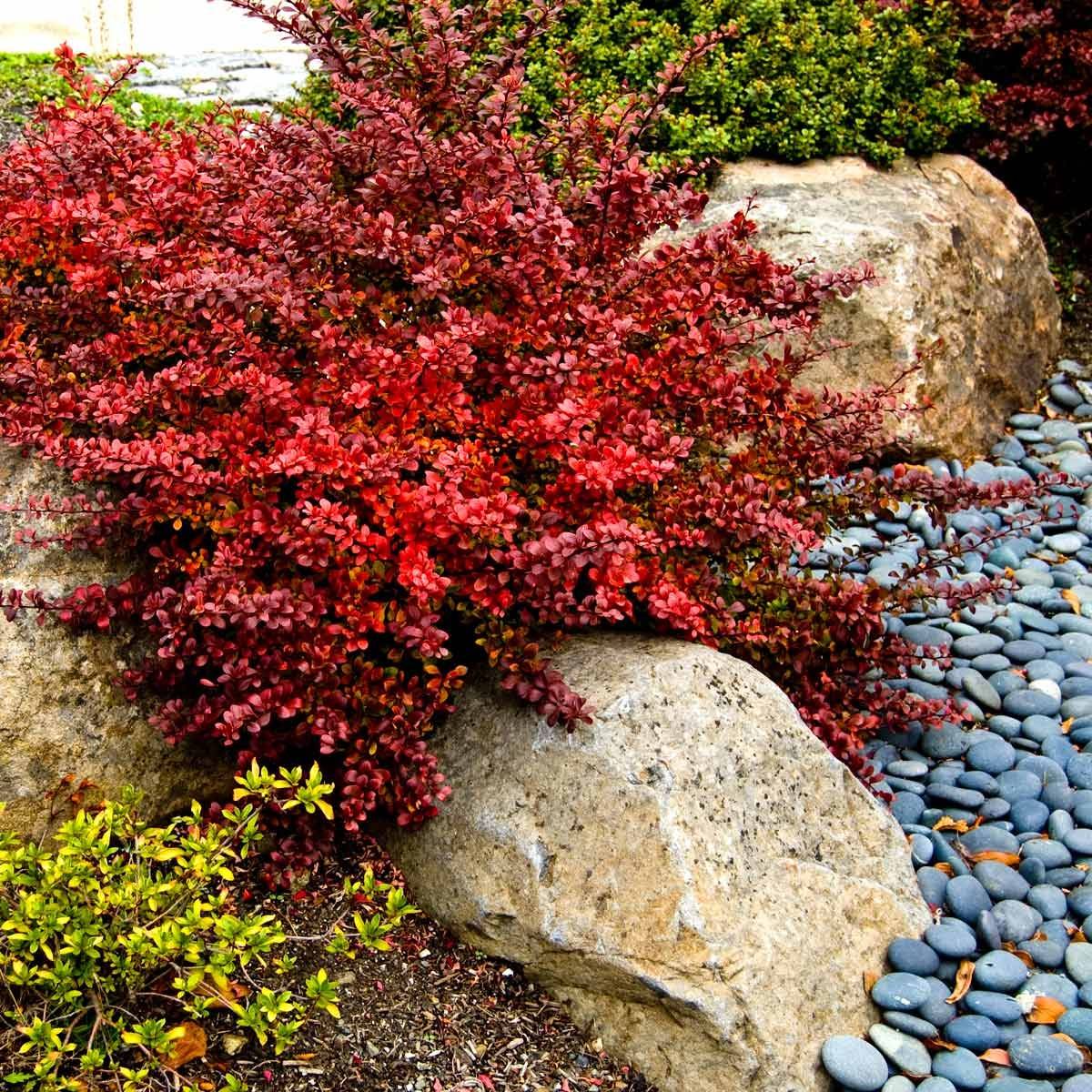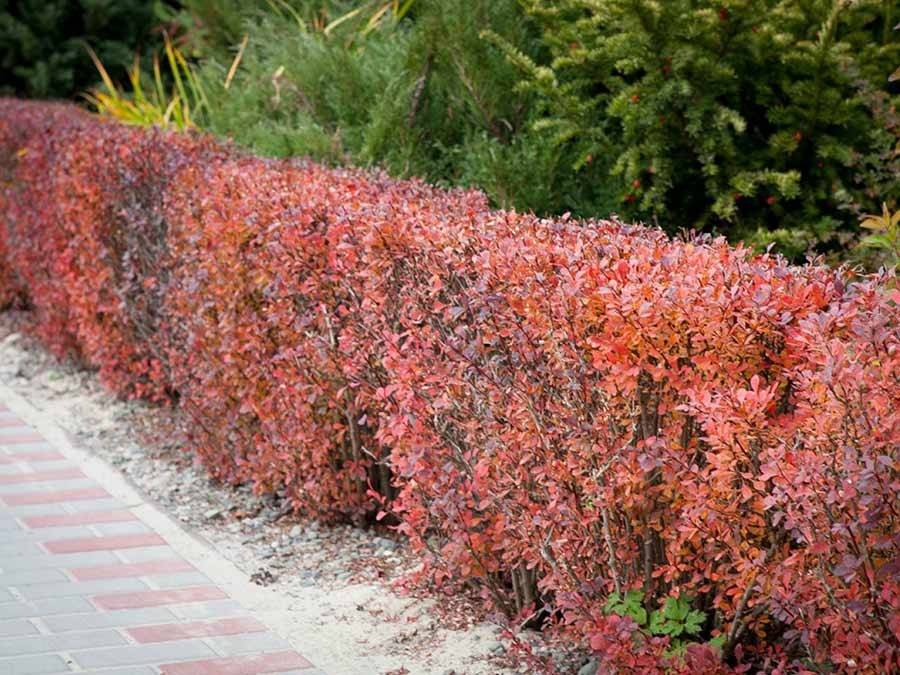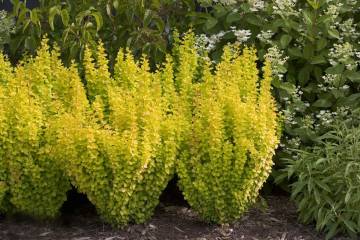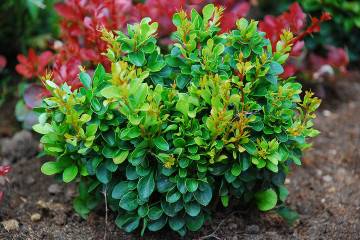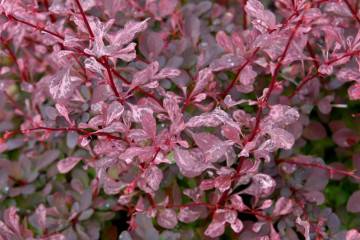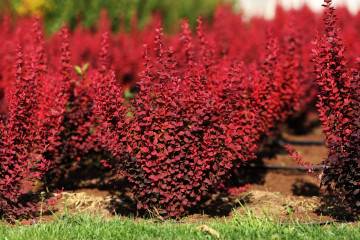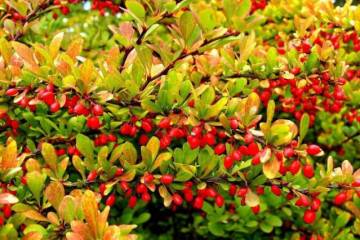Barberry Thunberg Atropurpurea - description
Content:
Barberry Thunberg Atropurpurea is an ornamental shrub for landscaping streets, suburban areas. In spring it is covered with beautiful dark purple foliage and bright, pleasantly scented flowers, gathered in a cluster. In autumn and late summer, the bright crown is strewn with ripening berries.
Description of barberry Atropurpurea
The variety has a lot of advantages. It tolerates heat and drought well. From the description of the barberry Atropurpurea, it follows that it can grow without shelter in almost the entire territory of Russia. The exceptions are the regions of the extreme south and extreme north. Winter hardiness of a perennial shrub corresponds to zone 3 according to the USDA classification. It can withstand short-term frosts of -37 ° C.
The name of the genus beiberi, to which the variety belongs, in Arabic means “with petals like shells”. This is true: if you look at the Atropurpurea flower, you can see 6 yellow-red petals, similar to shells.
Small leaves are 25 mm long, they are round or spatulate, collected in bunches. At the beginning of the growing season they are purple, in autumn they are bright red with a purple tint. Sprawling dense crown up to 2 m wide, up to 1.5-2 m high consists of erect skeletal branches and many thin, arched lateral shoots. The bark is reddish brown or yellowish. Single thorns. The root system is superficial, branched.
Planting a plant
Barberry Atropurpurea is planted singly, in groups or in a trench. The seedlings are bought in the nursery or grown by themselves. In good light, the color of the leaves is brighter, so the place is chosen sunny, even.
Planting from seeds
A hedge requires a lot of seedlings. They are grown from seeds harvested in the fall. Landing preparation technology is not complicated:
- in the fall, the fruits are harvested, cleaned of pulp;
- washed, dried;
- stored in a dry place;
- in February they take it out, fill it with water for 3 days;
- put in the refrigerator for 2 months.
In April, stratified seeds of Thunberg barberry are sown in a box filled with a mixture of garden soil, sand, peat (1: 1: 1) or on a small greenhouse bed. In the fall, seedlings are transplanted to a school or to a permanent place.
Planting seedlings in open ground
The life expectancy of the Thunberg barberry Atropurpurea is 50 years, so they are responsible for preparing the planting pit. For backfill, prepare a mixture:
- humus - 2 parts;
- sand - 2 parts.
Add 1 tbsp to a bucket of substrate. l. superphosphate.
| Planting method | Sapling age | Landing pit / trench size |
| pit | 1 year | 25 × 30 cm |
| 2 years | 50 × 50 cm | |
| trench | 1-2 years | width 40 cm, depth 40 cm |
Seedlings of barberry Thunberg are planted in a trench in increments of 40-50 cm.
How to care for barberry Atropurpurea
Barberry Atropurpurea grows slowly. Annual growth does not exceed 20-30 cm. Simple bush care consists of standard activities.
Watering
This is the main care after planting. At least 10 liters of water are poured onto each seedling. After rooting, watering is carried out 1 time in 7 days. The soil around the bush is soaked to a depth of 0.4 m.The decorativeness of adult plants depends on the moisture content of the soil, so irrigation is carried out regularly. Water is poured at the root, without splashing on the leaves.
Top dressing
If the common barberry Atropurpurea receives balanced mineral supplements, the decorative properties appear brighter.
| Period | Fertilizer | number | Frequency |
| early spring | urea | 30 g | 1 time in 4 years from the second year of life |
| water | 10 l | ||
| in May before the first buds appear, in June after flowering | manure | 1 kg | 2 times per year |
| water | 6 l | ||
| when the leaves fall | superphosphate | 15 g | annually to increase winter hardiness |
| potassium sulphide | 10 g |
Pruning
In the spring, the crown of Atropurpurea is examined, dry branches damaged by wind and frost are cut out. The second time, sanitary pruning is done in the fall. They remove shoots damaged by bad weather and pests. Formative pruning is done in the spring. The shrub tolerates it well.
Until the sap flow has begun, the crown is given the desired geometric shape, the hedges and curbs are aligned in height twice. The first time after the flowering of the Atropurpurea bushes, the second time as needed, the last time is mid-August.
Reproduction methods
More often barberry Atropurpurea is propagated vegetatively, less often by seeds. The old bushes are dug up in the fall, the rhizome is divided into parts with a shovel, the cuttings are seated in pits prepared in advance.
Propagated by layering in the spring. In the lower part of the crown, annual shoots are found, they are bent to the ground, pinned, the place of contact is spud, the crown is left outside. During the season, the roots are formed at the cuttings, in the spring they are cut off from the mother bush, transplanted to a permanent place.
Green cuttings barberry Atropurpurea is propagated in June:
- Choose the shoots of the current year.
- Cut the cuttings at least 10 cm long.
- Make sure there are 2-3 internodes.
- The lower cut is made at an angle of 45 °, the upper cut is straight.
- The leaves are cut off from below, the upper ones are shortened by ½ the length.
- Rooted in water, perlite, potting soil.
In the fall, cuttings of Atropurpurea are transplanted to a school for growing or directly to a flower bed, they are covered for the winter.
Diseases and pests
The Atropurpurea variety has good immunity, but there are pests and diseases from which it should be protected.
| Pest / disease | Way to fight |
| Aphid | soap solution |
| Moth | 1-3% chlorophos solution |
| Rust | bordeaux liquid |
| Powdery mildew | fungicides, 1% colloidal sulfur solution |
Leaves affected by the fungus are cut off, destroyed.
Flowering period
A deciduous shrub blooms in May, flowering lasts about 4 weeks, the exact timing depends on the climate in the region. The buds open along the entire length of the shoots. Bushes covered with bunches of two-colored flowers are decorative.
Ellipse-shaped fruits (their length is 8 mm) ripen in September, they are red, elongated, taste bitter - there are many alkaloids in the pulp. They are not used for food, in winter they hang on bushes, serve as food for birds.
Preparing for winter
In the southern regions, the crown of Atropurpurea is not covered for the winter, only the trunk circle is insulated. It is mulched with sunflower husk or peat. In a temperate climate, the Thunberg barberry is closed for up to 5 years for the winter:
- The branches of the bush are pulled together with a soft rope.
- A frame made of old boards is installed around the bush, and it is covered with a net.
- When the temperature is below zero, dry leaves are poured inside, the hut is wrapped with a piece of covering material.
Use in landscape design
The Atropurpurea variety grows well within the city, therefore it is actively used in the design of city parks and squares.The colorful compositions retain their decorative effect throughout the season. In September and October, the brilliant, purple-red foliage of the Purpurea barberry enlivens the bleak autumn landscape.
Barberry Thunberg tolerates pruning well, therefore specimens that have reached 5 years of age are used to create topiary - shrub sculptures. This element of landscape design can be found in an amateur garden and city park.
More often hedges are formed from shrubs. A dense plantation performs a decorative and functional load: it masks fences, serves as a dividing strip, and is a background for other plants.
In summer cottages, ornamental shrubs are used in group plantings or as a tapeworm. The bright crown of the Thunberg barberry against the background of the emerald lawn and tall conifers creates the right color accent.
Beneficial features
The red fruits of the Thunberg barberry are used to make a hair rinse and skin rejuvenator. There is only one cooking recipe:
- 1 tbsp. Atropurpurea berries are poured with 1.5 l of boiling water for 40 minutes;
- filter.
Freshly washed hair is rinsed with warm solution. It increases volume, relieves dandruff.
For face care, the infusion is frozen in a silicone form. Rub the skin with cubes. The product reduces and smoothes wrinkles, improves tone.
The main use of deciduous shrubs is landscape design. It is not difficult to propagate the Thunberg barberry, it is easy to care for, it is easy to form a crown. This is appreciated by professional designers and amateur gardeners.
